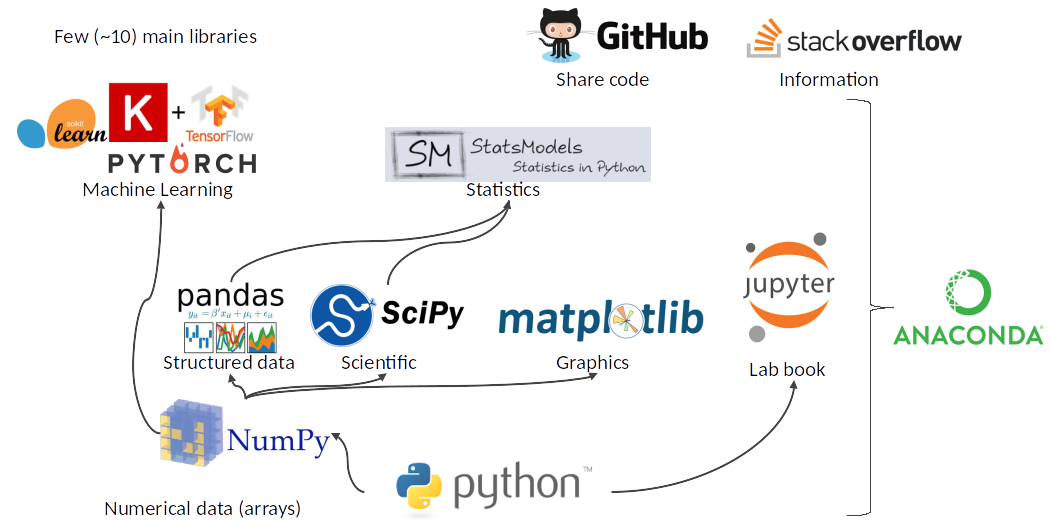Python ecosystem for data-science¶

Python language¶
Python is popular Google trends
Interpreted: source file
.py=> interpretor => processor versus compiled, two steps (1) source file => compilaton => binary file. (2) Execution is simply binary file => processor.Garbage collector (do not prevent from memory leak)
Dynamically-typed language (Java is statically typed)
Anaconda¶
Anaconda is a python distribution that ships most of python tools and libraries
Installation
Download anaconda (Python 3.x) http://continuum.io/downloads
2. Install it, on Linux
bash Anaconda3-2.4.1-Linux-x86_64.sh
3. Add anaconda path in your PATH variable in your .bashrc file:
export PATH="${HOME}/anaconda3/bin:$PATH"
Managing with ``conda``
Update conda package and environment manager to current version
conda update conda
Install additional packages. Those commands install qt back-end (Fix a temporary issue to run spyder)
conda install pyqt
conda install PyOpenGL
conda update --all
Install seaborn for graphics
conda install seaborn
# install a specific version from anaconda chanel
conda install -c anaconda pyqt=4.11.4
List installed packages
conda list
Search available packages
conda search pyqt
conda search scikit-learn
Environments
A conda environment is a directory that contains a specific collection of conda packages that you have installed.
Control packages environment for a specific purpose: collaborating with someone else, delivering an application to your client,
Switch between environments
List of all environments
- ::
conda info –envs
Create new environment
Activate
Install new package
conda create --name test
# Or
conda env create -f environment.yml
source activate test
conda info --envs
conda list
conda search -f numpy
conda install numpy
Miniconda
Anaconda without the collection of (>700) packages.
With Miniconda you download only the packages you want with the conda command: conda install PACKAGENAME
Download anaconda (Python 3.x) https://conda.io/miniconda.html
Install it, on Linux
bash Miniconda3-latest-Linux-x86_64.sh
Add anaconda path in your PATH variable in your
.bashrcfile:
export PATH=${HOME}/miniconda3/bin:$PATH
Install required packages
conda install -y scipy
conda install -y pandas
conda install -y matplotlib
conda install -y statsmodels
conda install -y scikit-learn
conda install -y sqlite
conda install -y spyder
conda install -y jupyter
Commands¶
python: python interpreter. On the dos/unix command line execute wholes file:
python file.py
Interactive mode:
python
Quite with CTL-D
ipython: advanced interactive python interpreter:
ipython
Quite with CTL-D
pip alternative for packages management (update -U in user directory --user):
pip install -U --user seaborn
For neuroimaging:
pip install -U --user nibabel
pip install -U --user nilearn
spyder: IDE (integrated development environment):
Syntax highlighting.
Code introspection for code completion (use
TAB).Support for multiple Python consoles (including IPython).
Explore and edit variables from a GUI.
Debugging.
Navigate in code (go to function definition)
CTL.
3 or 4 panels:
text editor |
help/variable explorer |
ipython interpreter |
Shortcuts:
- F9 run line/selection
Libraries¶
scipy.org: https://www.scipy.org/docs.html
Numpy: Basic numerical operation. Matrix operation plus some basic solvers.:
import numpy as np
X = np.array([[1, 2], [3, 4]])
#v = np.array([1, 2]).reshape((2, 1))
v = np.array([1, 2])
np.dot(X, v) # no broadcasting
X * v # broadcasting
np.dot(v, X)
X - X.mean(axis=0)
Scipy: general scientific libraries with advanced solver:
import scipy
import scipy.linalg
scipy.linalg.svd(X, full_matrices=False)
Matplotlib: visualization:
import numpy as np
import matplotlib.pyplot as plt
#%matplotlib qt
x = np.linspace(0, 10, 50)
sinus = np.sin(x)
plt.plot(x, sinus)
plt.show()
Pandas: Manipulation of structured data (tables). input/output excel files, etc.
Statsmodel: Advanced statistics
Scikit-learn: Machine learning
library |
Arrays data, Num. comp, I/O |
Structured data, I/O |
Solvers: basic |
Solvers: advanced |
Stats: basic |
Stats: advanced |
Machine learning |
|---|---|---|---|---|---|---|---|
Numpy |
X |
X |
|||||
Scipy |
X |
X |
X |
||||
Pandas |
X |
||||||
Statmodels |
X |
X |
|||||
Scikit-learn |
X |